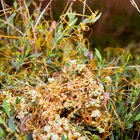Saw palmetto, an herbal extract derived from the deep red fruit of a small palm tree, is used as an active ingredient in a number of popular hair loss treatments on the market today. The liposerolic extract from the fruit is also purported to help with benign prostate enlargement in men. Dosage recommendations for saw palmetto are controversial due to the limited amount of actual clinical study done on the herb relating to the efficacy of the extract in promoting hair growth.
Clinical Studies
In 2002, The Journal of Alternative and Complementary Medicine published a preliminary study that showed related results between saw palmetto and hair growth. The study was conducted with a small group of 19 men between the ages of 23 and 64 who took 400 mg of saw palmetto coupled with 100 mg of Beta-sitosterol and a placebo. Results showed a 60 percent improvement of hair growth in men who took the herbal combination over the placebo group. More studies will need to be performed to better test its effectiveness on hair loss.
Side Effects
Saw palmetto may produce minor side effects including constipation, nausea, diarrhea, breast tenderness or enlargement, erectile dysfunction, vomiting and bad breath. Safety for pregnant and nursing women has not yet been determined. Many stomach upsets caused by the supplement may be lessened by taking it combined with food. Manufacture of saw palmetto is not regulated, so it is important to choose a manufacturer who can be trusted. Standardized saw palmetto should have consistent doses of the active components of the extract.
Dosage
There is no recommended dosage for taking saw palmetto for hair loss. A variable to hair loss is excess DHT (a testosterone metabolite) in hair tissue. It has been speculated that saw palmetto inhibits the enzyme 5 alpha reductase that converts testosterone into DHT in prostate tissue, but studies have not been done to prove a similar effect would occur in hair tissue. Studies conducted on standardized saw palmetto for enlarged prostate treatment in men used dosages of either 160 mg twice daily or 320 mg once daily.
Related Articles

What Are the Benefits of Extrapone ...

Can Drinking Nettle Tea Reduce DHT ...

Aloe Ferox Benefits

Bromelain & Bruising

What Are the Dangers of 6 Oxo?

Traditional Uses of Cuscuta

Are There Herbal Treatments for ...

Olive Leaf Extract for Skin Problems

Can Apples Promote Hair Growth?

Herbs For Melasma

Horsetail vs. BioSil

Difference Between Women's Rogaine & ...

What Foods Provide Calcium D-Glucarate?

Snail Cream Benefits

Metamucil Dosage for Cats

Can Borage Oil Help Acne?

Skin Care Products That Contain ...

L-Lysine for Hair Growth

Chasteberry for Acne

Zinc Treatment for Rosacea
References
Writer Bio
Abaigeal Quinn works as an international entertainment broker in the United States. She is a former news editor and insurance agent who began writing for a daily newspaper in 1995.